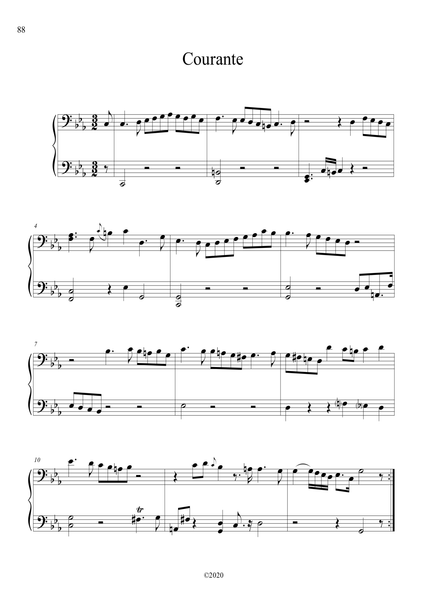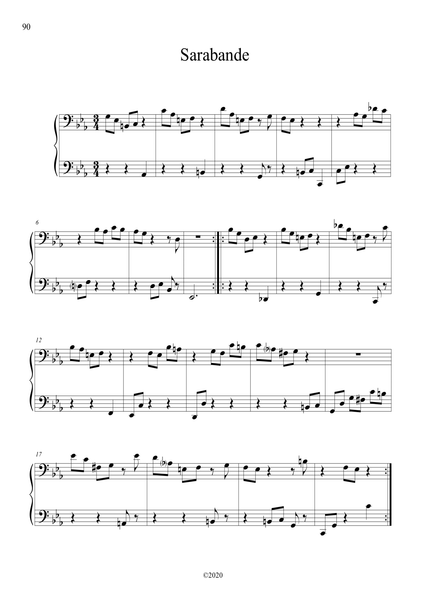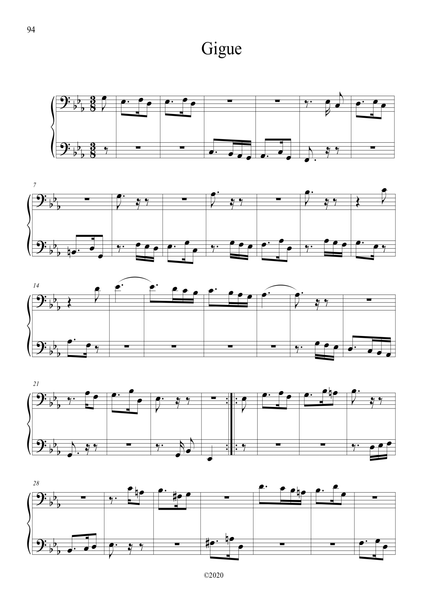J.S. Bach: Cello Suite No. 5 in C minor, BWV 1011 – arranged for piano by Eleonor Bindman (GPC079)
This is the sheet music edition of a new piano arrangement of the Bach Cello Suite No. 5 in C minor by Eleonor Bindman.
Solo piano
17 pages
Duration: 21:37
Audio samples
Buy, stream and download the CD here.
Unlike the first three, Suites 4, 5 and 6 lack a common structural “seed,” and get progressively longer and more varied in their expression. As the middle of the second set, Suite No. 5 is written in a minor key - like Suite No. 2 - and is an important transition to Suite No. 6 in length and complexity. The color that comes to mind is purplish-black, maybe because I hear the beginning as very dramatic, the feeling of C minor recalling the introduction of Beethoven’s piano Sonata Op. 13 (known as “The Pathetique”) and Bach’s own keyboard Partita No. 2. Bach adds a little hurdle for the cellist by indicating a different, lower tuning of the highest string, from A natural, which doesn’t “belong” in C minor to G, the dominant. He actually transcribed this Suite himself for the lute, as BWV 995.
The Prelude of Suite No. 5 is actually a prelude and fugue, written in two distinct sections. The introduction in French Overture style sustains long implied pedal points (C for nine measures and G for five measures) before a glimpse of the relative E-flat major in m. 17. After this brief ray of light we are immediately cast back into despair of G minor in mm. 18-21. A C minor 7th chord in m. 22 starts an improvisatory transition to the second section: in much faster 3/8 time, structurally a fugue, despite being notated in one voice only. This movement is an excellent demonstration of Bach’s “implied counterpoint” craftsmanship: even the fugue’s subject contains a sequence of three ascending notes which may be interpreted as a dialogue. He dresses the subject and its components in various guises with virtuosity and humor, going through a multitude of keys. In m. 171 we have a “deceptive” G pedal point which feels like a final cadence but instead results in a coda of sorts, repeating the subject then pushing off the same low G into ascending arpeggios in mm. 189-195, ending on a G7 chord. The subject is stated for the last time in m. 197 and even extended with a third internal sequence, (in the recording I play left-hand octaves in mm. 197-203 and 206). Then the bass leads from F to F# to a G before plunging us back down into a low C, starting the closing fifteen measures which contain yet another chromatic – and therefore dramatic – ascent in the bass from C, D, E flat to E natural, F to F sharp to G. Playing the last page of this Prelude makes me feel more like a rock guitarist than a classical pianist. Approximate target tempi are: prelude at 63 per quarter, then fugue at 72 per dotted quarter note.
After the intense ending of the Prelude, the Allemande feels very stately, more of a march than a dance, maybe even a funeral one, its dotted rhythms and 32nd notes echoing the French Overture opening. Bach writes an abundance of chords, more than in any preceding Allemande, with clearly indicated harmony changes. Target tempo is around 80 per quarter note.
Our Courante, the only one written in 3/2 time, sounds quite energetic and direct, I’d play it at 88 per half note. This movement, like the Allemande, has harmonies punctuating almost every measure, exaggerating the first beats and making the phrase endings sound almost abrupt. The mood is hard to pin down but the “stomping” feel of the downbeat and sharp rhythm make me think of a later dance form, the Polonaise, which usually has a different beat subdivision but is also in triple time.
The unusual harmonic blueprint of Suite No. 5 is continued in the Sarabande, written exclusively monophonically. It’s almost like a “binary” computer language in that its building blocks are either pairs of 8th notes or single quarter notes. Speed: 60-72 per 8th note. I won’t attempt to further describe this movement; hearing it speaks volumes where words fail. To me, it is the most perfect emanation, the soul of the entire Cello Suites cycle.
Gavotte I is a bit melancholic, still carrying a residue of the Sarabande, but with playful little echoes. Gavotte II, in the same key of C minor, is a single legato line in triplet rhythm, sounding like something Brahms might have written, very passionate and rhapsodic. Here Bach twice repeats the content of the short four- measure first half during the eighteen-measure second half, so I think it makes sense not to take this particular repeat. The pair sounds good in the same tempo – with some rubato possible in Gavotte II – at around 69 per half note.
This Gigue is in French style, built on short repeated dotted-rhythm fragments with many sequences, and written in 3/8 time. The relentless drive and fast tempo seem surprisingly interrupted by long notes. For the repeats, in mm. 15, 18, 61 and 64, I liked the idea of inserting the dotted thematic fragment underneath the held notes, re-filling the rhythmic “negative space” in a way. In mm. 55-56, Bach creates two consecutive chromatic trills culminating in the highest note of the movement, an F above middle C. After such a moment of drama, the final descent sounds even more authoritative. A good tempo would be 80 per dotted quarter note.
– Eleonor Bindman
















